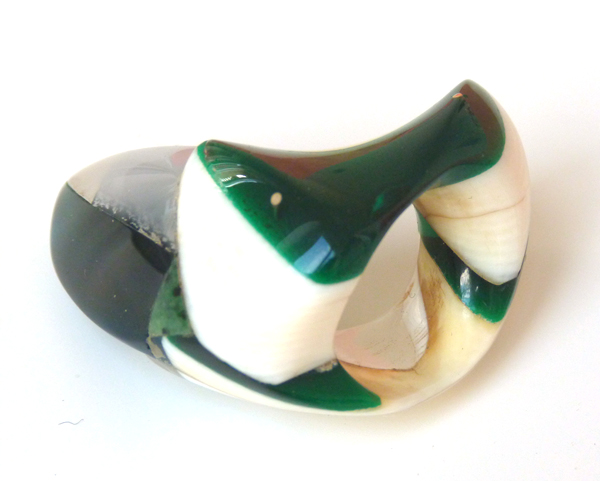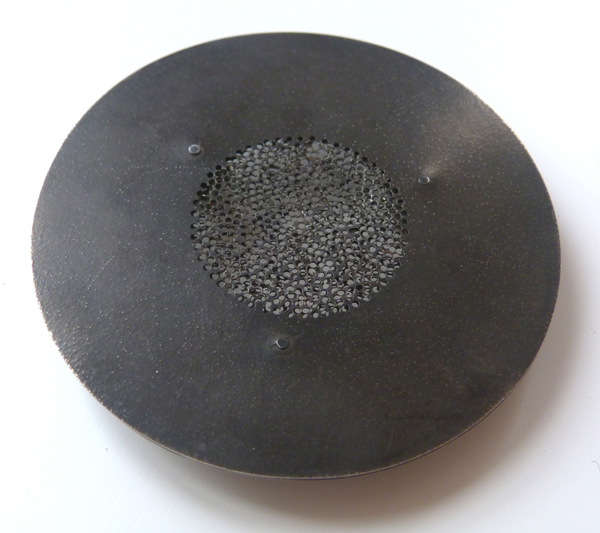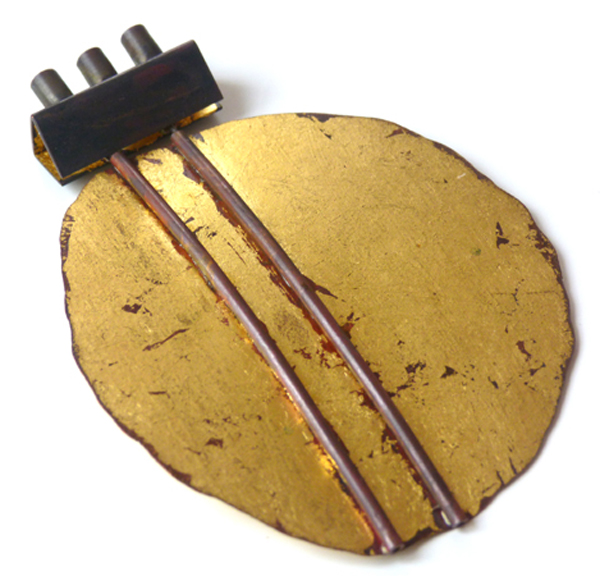In May 2011, I spent a week in Paris, getting to know a bit more about the French contemporary jewelry scene. Through the kind assistance of French jeweler, writer, and AJF editor Benjamin Lignel, I had the opportunity to meet and interview French collectors and curators for the AJF website. Pascale Gallien is a lawyer and jewelry collector who kindly spent an hour showing Benjamin and me her collection and discussing what motivates her interest in contemporary jewelry.
The intimacy of wearing is critical to Pascale. It is the way she integrates these objects into her life. Collecting as an activity that results in a group of objects that might have their own identity apart from her decision to choose and wear them is not the point here. And the centrality of wearing has another significant impact on Pascale’s collecting activities—she doesn’t use the Internet to buy her jewelry. She needs to see it, touch it, and try it on before a purchase can happen. While Pascale’s collection does include some work by well-known contemporary jewelers, much of it is not by makers who operate within the field. I’d describe the overall nature of the collection as jewelry that subtly protests against societal expectations as to what jewelry will look like and be made of.
Damian Skinner: So you wear most of the jewelry that you own?
Pascale Gallien: Oh yes, of course.
Damian Skinner: Not all contemporary jewelry collectors wear what they own. Sometimes they buy a piece for intellectual reasons or because they respect the object as art, but they don’t ever wear it.
First, I would not consider myself a collector. You have collectors, people who can say, “I want that piece and that piece.” I am really just one of those people who buys from time to time. My first feeling, my first reaction is that I just like the pieces and feel like wearing them. It’s about a behavior. It’s about a way of approaching life, of being in life—and that was what attracted me first. Not collecting or accumulating jewelry from a certain time. I don’t know if it is emotional. I think you realize in the way you choose things in life to have around you that there is something consistent or something constructive or more comprehensive.
Damian Skinner: So, you would draw a distinction because you are purchasing an object for its emotional relationship to you in the act of wearing, as opposed to purchasing it to fit with another piece you bought 10 years ago.
Indeed. I never approach things in that kind of way. I just look at jewelry because, of course, I am attracted to the piece itself, the materials used, and the format. I like minimalist jewelry. The baroque things are not for me. I would not buy them. They may be pieces I could admire, but I would never wear them, and if I don’t wear them, I don’t buy them.

Benjamin Lignel: So you’ve never purchased a piece that you haven’t worn?
No. Never.
Damian Skinner: Yet, you do wear quite prominent jewelry. Some of the rings you own are not subtle or small. But there are some types of large-scale work you just wouldn’t wear?
I do have quite significant pieces around the fingers, but not around the neck. I wear discreet things around the neck. What I also think I need is a connection to the architecture of a piece. I like when jewelry is quite structured. This doesn’t mean that I could not like other types of pieces, but I simply wouldn’t wear them. And it’s also linked into the type of materials used. If a piece is too flashy with too many colors, it’s not for me.
Damian Skinner: What would be the problem with owning a piece of jewelry that you didn’t wear? Why must you wear it?
I derive pleasure from living with pieces, and I need to make them part of my life. I do not collect for lucrative purposes. I will never sell pieces unless I’m really starving! They just need to be part of my life. I think it’s an intimacy, an intimate relationship with the work.
Benjamin Lignel: I think one of the reasons Damian asks that question is because there are some collectors of contemporary jewelry who never wear it. They collect it like a painting or sculpture and have a special cabinet made. It becomes more something they have in their home.
No, I don’t display pieces like that. You will see that my jewelry is all in a couple of boxes in a corner of my private place at the end of the apartment. I don’t wear them all the time because it’s really a question of mood or until I think of them. Some of the jewelry I won’t wear for a couple of months, years sometimes, and then I come back to them. But they all are linked to my behavior, my way of life.
Damian Skinner: So you’re wearing four piece of jewelry at the moment. Is it common for you to wear multiple pieces?
![Stéphane Landureau, 2 pour 1 [2 for 1], 2001, rings (both squashed version and its replacement), silver; 35 x 20 x 12 mm, photo: Pascale Gallien Stéphane Landureau](https://artjewelryforum.org/sites/default/files/images2013/collector-profiles/pascale-gallien/content/3-bague-e%CC%81crase%CC%81e-600px.jpg)
Damian Skinner: “I loved it so much!”
Yes, it suffered from that. The maker restored it and sent it back, I was so happy. Later, I lost it on the floor at a function, and it broke again. I took it back to the gallery. Rather than repair it, the artist made another one for me. But the broken one is still here, in a box in the corner.
Damian Skinner: So, because you have formed an attachment, you can’t actually let go of the piece, even though it doesn’t work anymore.
No, I have it here as a kind of “generation” issue, a former one.
Damian Skinner: So, when did you start buying jewelry of this type?
I started in my twenties. It is 25 years later now, so . . .
Damian Skinner: What drew your interest?
The first time you don’t know. It’s just looking at something and feeling like you want to have it and to wear it. It was not something I thought about consciously, like “I’m going to collect this jewelry.” It was more about feeling, let’s say an emotional approach if you like, although I’m not sure it’s only emotional. It’s something instantaneous.
Damian Skinner: Were you conscious that you were interested in acquiring pieces that were not typical jewelry, that were different in some way?
Yes, very rapidly. Not a lot of people wear this type of jewelry.
Damian Skinner: Did you ever think, “Why am I interested in this jewelry as opposed to the sort that everyone generally tends to buy?”
I’m not interested in everybody’s way, especially in our society. At the time, you do it just because you like it. It’s not something that is intellectualized. You progressively realize or understand that wearing jewelry is also a political way of presenting yourself, in a way where everything is standardized and you’re expected to fit in. I work in a lawyer’s environment, and I can tell you that people are quite classical in the way they dress. The same type, same format, but I am not that way.
Benjamin Lignel: Did you know that this work was called contemporary jewelry? Did you know it by name then?
I don’t know whether I needed to name it, but I knew it was something that was created by people of my age, of my generation. But again, it’s the same thing as looking at art today, or looking at music. I like contemporary music. We’re in a different type of society, so classical music written by people today, well, it’s less and less interesting. This jewelry is a way of looking at things around you. This doesn’t mean that we should deny the past. People who have a high level of culture look at a lot of things. But, being fluent in what is happening around you is, to me, essential.
Damian Skinner: Are you describing a tendency within French society to favor the past over the present?
![Florence Croisier, Maille [Knit], 2009, bracelet, anodized titanium wire; 90 mm diameter x 45 mm height, photo: Pascale Gallien Florence Croisier](https://artjewelryforum.org/sites/default/files/images2013/collector-profiles/pascale-gallien/content/4-f-croisier-bracelet-600px.jpg)
Yes. It’s always more comfortable not to question yourself. You feel secure with something already recognized as being good or beautiful.
Damian Skinner: Do you see the jewelry you own and wear as having a political or cultural function, because it is a way of saying something to other people?
Yes.
Damian Skinner: Do you own any jewelry that has strong political or other kinds of meaning added by the artist?
No, I don’t think so. Maybe you would think differently by looking at the pieces, but I don’t think so. And I don’t think I would want such work, although I can understand that approach. It’s not my way of opposition.
Benjamin Lignel: I think what’s political is the attitude in choosing not to wear what everyone else is wearing and to make a conscious decision to go for what conforms to your taste.
Yes, more than claiming something with a connection to a specific political body or set of beliefs.
Damian Skinner: France has a big investment in luxury jewelry—diamonds and gold and elegant high-end jewelry products. Clearly when you wear a big ring made of wood or Corian, it’s in some ways an alternative to a big ring made of diamonds.
To me, yes.
Benjamin Lignel: Is your question whether choosing that ring is part of a political statement?
I think what I would like is if someone used diamond and wood. The more modern kinds of jewelry you see in Paris shop windows aren’t so interesting because they don’t go far enough. I could wear some diamonds with wood, but as of today I’ve never found something that attracted me and was interesting enough. It doesn’t mean that I would reject wearing diamonds as a matter of principle. It would just be interesting seeing them paired with a more unusual material. That makes sense according to the way I look at jewelry.
Damian Skinner: How often do you buy jewelry?
When I find something I like. I don’t go to galleries too much because then I would spend too much! If I have the intention of buying something in mind and if I see three pieces I like, I will buy all three of them.
Damian Skinner: Because wearing is very important, would it be hard for you to purchase jewelry over the Internet?

Damian Skinner: So that means that, unless you are travelling, you need to buy here in Paris.
Yes. I think I’ve never bought outside Paris because I don’t know the places. I don’t take the time when I’m travelling. I have other spots to visit first, and I’m not minded that way. I suppose I could.
Damian Skinner: That does make you quite different from most of the collectors with whom we’ve spent time. They are very conscious of using the Internet to gain access to other countries, and they make the most of global communication to see what’s happening in other places.
In France … French collectors?
In France, you’re probably one of the two French collectors, or maybe ten.
But, in Europe or the United States?
Damian Skinner: Yes.
I don’t do that at all. I’m not systematic in the way I buy jewelry. It’s not logical to that extent.
Damian Skinner: But there must have been a time in which you looked around and thought that you had many more pieces of jewelry than a normal person should ever have and that you were different in some way.
Yes.
Damian Skinner: I doubt anyone sets out to be a collector. I think it’s something that happens to you at a certain point when you realize you have too many things for them to be connected to you in an ordinary, normal way.
Yes, or that it is meaningful. It’s more than just being related to you. It’s one of the good things about getting older. You just sit and look at your past as something that makes sense to an extent.
Benjamin Lignel: Have you pursued the idea of meeting artists or doing private commissions?
For the jewelry, no. I know a lot of artists, painters, and sculptors. Some of them are friends, and some quite well connected. Maybe it’s because I didn’t look at those pieces of jewelry first. It was more about wearing them than looking at them.
Damian Skinner: It’s very interesting meeting you because one of the ideas I’ve been thinking about lately is how much contemporary jewelry pretends it needs a wearer, but actually it really doesn’t need a wearer, it just needs someone to buy it and look at it. You don’t have to have it on your body at all. Many pieces of contemporary jewelry are self-sufficient objects expressing what the artist has to say. It’s really interesting to find someone who buys contemporary jewelry purely to wear it.
For the artist it’s not usual? They design a piece of jewelry hoping that someone will wear it, no?
Benjamin Lignel: Now, today, it’s unclear. In the past 10 years, a lot of museums have been interested in buying contemporary jewelry, and it seems contemporary jewelers have started making pieces, in a way, specifically for museums. Obviously, if you make a piece for a museum, it’s not going to be worn. This elicits more and more installation work or pieces that are maybe about use but don’t actually need use. Damian came to Paris with two American collectors. One of them has an amazing collection, and she never wears any of the pieces.
Does she wear jewelry?
Benjamin Lignel: None at all. She has a really substantial collection—very beautiful pieces, very coherent choice. I’ve never seen her wear anything. Not a ring. Nothing. Then again, the other collector does wear her jewelry. She buys because she is a collector of contemporary jewelry. She buys things she can wear, but she isn’t afraid to buy things that could hardly ever be worn. She buys jewelry to fill the holes in her collection.
It’s interesting to put jewelry in a museum, but to travel and make sure the pieces are shown to people … they astonish people. I see a lot of people in the underground either looking at my hands or looking at the pieces I wear, and I think there is something positive in that.
Damian Skinner: Have you ever given any thought to what you will do with your jewelry when you no longer want it?
I don’t have kids. I could very easily give it to a museum or something like that. I would be concerned that the people who have the jewelry would appreciate it. It’s something very important to me. I would want the pieces to be looked at as they need to be looked at, or as they should be looked at.
Benjamin Lignel: How should they be looked at?
Not as something that is, I would say, anecdotal, but something that is meaningful. A role in the way of art.
Damian Skinner: And yet it’s a very personal art, because it’s about you. You have turned these objects into something that is very personal to you.
Yes, also that, because I see them as part of my intimacy.
Damian Skinner: So, in some ways, it’s very hard for anyone else to own the jewelry because you have already transformed it through your active love of wearing.
I would not expose the jewelry here, in my place. I would not have a display cabinet because I would not feel it was correct. It would be like exposing myself.

No, that’s true. I’ve never thought about it, but it’s true. But then again, I’ve never thought of myself as a contemporary jewelry collector.
Benjamin Lignel: It’s so fraught with contradiction. You say that you will not have a cabinet in your space, and yet you wear the jewelry every day. You enjoy tremendously the fact that it lives through the eyes of other people in the subway, so it is clear that you are showing the jewelry to the public.
Yes, but just exposing. I like the jewelry being alive. I would say that putting them in a cabinet would not support them being alive. In a cabinet they would be dead pieces just to be looked at. The jewelry needs to be worn.
Damian Skinner: So, display is okay as long as it’s on someone’s body?
Yes. It’s what I find interesting. It shows people that pieces that are strange to them can be worn and enjoyed. That’s what I’m interested in. And just going to a museum and saying, “oh, look at them,”— you have a kind of distance. This way, you don’t have distance anymore.




